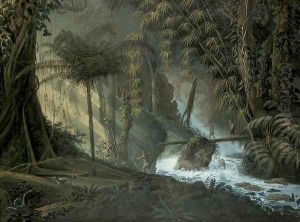Charles Comte de Clarac Paintings
Charles Othon Frédéric Jean-Baptiste de Clarac, known as the Comte de Clarac, was a French artist, archaeologist, and museum curator born in 1777 in Paris, France. Hailing from an aristocratic background, Clarac's life was marked by the tumultuous events of the French Revolution and the Napoleonic Wars, which significantly influenced his career path and intellectual pursuits. Despite the societal upheavals of his time, he managed to carve out a distinguished career in the arts and archaeology, contributing significantly to the understanding and appreciation of ancient art and culture in the 19th century.
Clarac's early education was steeped in the classics, encouraging a lifelong fascination with the ancient world. This interest led him to pursue studies in art and archaeology, disciplines that were gaining prominence in European intellectual circles at the time. His talents and aristocratic connections allowed him to travel extensively, particularly in Italy and Greece, where he studied ancient artifacts and ruins firsthand. These experiences were crucial in shaping his future work, both as an artist and as a scholar.
In 1805, Clarac embarked on a significant career milestone by joining the Musée Napoléon (later renamed the Louvre Museum) in Paris. He was instrumental in the reorganization and cataloging of the museum's collection of ancient sculpture, applying rigorous scholarly methods to the study and presentation of artifacts. His work at the Louvre was groundbreaking, influencing museum practices and the academic field of archaeology. Clarac published several influential works during his tenure, including the 'Musée de sculpture antique et moderne' (Museum of Ancient and Modern Sculpture), which became a seminal reference in the study of classical sculpture.
Beyond his contributions to museum curation and scholarship, Clarac was also an accomplished artist. He was known for his detailed drawings and engravings of ancient sculptures and artifacts, which were widely praised for their accuracy and artistry. These works not only served as valuable scholarly resources but also helped to popularize classical art among the European public.
Clarac's legacy is multifaceted, encompassing his contributions to the arts, archaeology, and museum practices. His work laid foundational principles for the modern study of ancient art and played a crucial role in the development of art history as a discipline. The Comte de Clarac passed away in 1847, leaving behind a rich body of work that continues to influence scholars and art enthusiasts alike. His life and career remain a testament to the enduring fascination with the ancient world and its cultural heritage.
